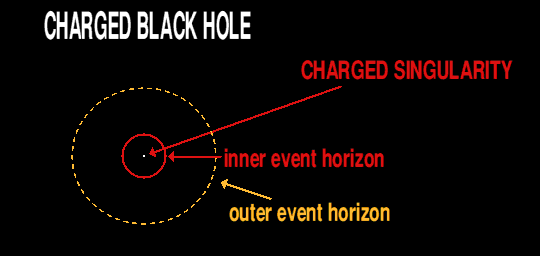

If we start off with a neutral Black Hole, which has but one event horizon, and start adding an electrical charge to the singularity, then a second event horizon, small and near the singularity at first, appears. As more electrical charge is added, the inner event horizon grows larger whilst at the same time the outer event horizon grows smaller.
As more and more charge is added eventually the two event horizons coincide. At this point the singularity becomes naked, and is referred to as a naked singularity. No one knows if naked singularities can exist, or what would be the consequences for the Universe if one did. The prospect is daunting.
A charged Black Hole was first investigated mathematically in 1916-1918 by H. Reissner and G. Nordstrom, and is therefore sometimes referred to as a Reissner-Nordstrom black hole.
Although it is theoretically possible to have a charged black hole, most matter in the Universe is neutral, composing equal parts positive and negative charges. All stellar objects so far observed are believed to be neutral, so it would be most unlikely for a charged black hole to form. But if one did, with electrical force being 1039 times stronger than the gravitational force, the effect of a charged black hole would be immediately obvious, its' electrical field would be enormously powerful and would stretch great distances across the Universe ionising inter-galactic hydrogen atoms. It would also quickly attract charges of opposite polarity which would eventually neutralise any charge.
![]()